Printing press: Difference between revisions
Revert to revision 396934115 dated 2010-11-15 16:33:01 by Stephenb using popups |
No edit summary |
||
| Line 549: | Line 549: | ||
*[http://www.archive.org/details/Printing1947 Internet Archive: Printing (1947)] − a film from the Prelinger Archives explaining the printing industry |
*[http://www.archive.org/details/Printing1947 Internet Archive: Printing (1947)] − a film from the Prelinger Archives explaining the printing industry |
||
*[http://videos.howstuffworks.com/hsw/11686-careers-for-the-21st-century-printing-press-operators-video.htm Careers for the 21st Century: Printing Press Operators] |
*[http://videos.howstuffworks.com/hsw/11686-careers-for-the-21st-century-printing-press-operators-video.htm Careers for the 21st Century: Printing Press Operators] |
||
*[http://offsetpressman.blogspot.com/2009/10/what-makes-good-press-operator.html Qualifications For A Press Operator] |
|||
{{DEFAULTSORT:Printing Press}} |
{{DEFAULTSORT:Printing Press}} |
||
Revision as of 18:49, 20 November 2010
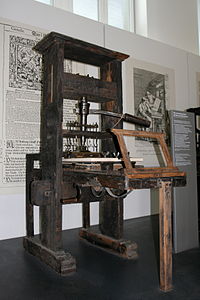

A printing press is a device for applying pressure to an inked surface resting upon a print medium (such as paper or cloth), thereby transferring the ink. Typically used for texts, the invention and spread of the printing press are widely regarded as the most influential events in the second millennium AD,[1] revolutionizing the way people conceive and describe the world they live in, and ushering in the period of modernity.[2]
The mechanical systems involved were first assembled in the Holy Roman Empire by the German Johannes Gutenberg around 1440, based on existing screw presses. Gutenberg, a goldsmith by profession, developed a complete printing system, which perfected the printing process through all its stages by adapting existing technologies to printing purposes, as well as making ground-breaking inventions of his own. His newly devised hand mould made for the first time possible the precise and rapid creation of metal movable type in large quantities, a key element in the profitability of the whole printing enterprise.
The mechanization of bookmaking led to the first mass production of books in history in assembly line-style.[3] A single Renaissance printing press could produce 3,600 pages per workday,[4] compared to forty by hand-printing and a few by hand-copying.[5] Books of bestselling authors like Luther or Erasmus were sold by the hundred thousands in their life-time.[6]
From a single point of origin, Mainz, Germany, printing spread within several decades to over two hundred cities in a dozen European countries.[7] By 1500, printing presses in operation throughout Western Europe had already produced more than twenty million volumes.[7] In the 16th century, with presses spreading further afield, their output rose tenfold to an estimated 150 to 200 million copies.[7] The operation of a press became so synonymous with the enterprise of printing that it lent its name to an entire new branch of media, the press.[8] As early as 1620, the English statesman and philosopher Francis Bacon could write that typographical printing has "changed the whole face and state of things throughout the world".[9]
From its beginnings, printing was practiced also as a true art form, setting a high aesthetic and artistic standard, such as in the famous 42-line Bible. Today, incunables are among the most prized possessions of modern libraries.
The unprecedented impact of Gutenberg-style printing on the long-term development of modern European and then world history is difficult to capture in its entirety. Attempts at analysing its manifold effects include the notion of a proper Printing Revolution and the creation of the Gutenberg Galaxy. The ready availability and affordability of the printed word to the general public boosted the democratization of knowledge and laid the material basis for the modern knowledge-based economy.
In Renaissance Europe, the arrival of mechanical movable type printing introduced the era of mass communication which permanently altered the structure of society: The relatively unrestricted circulation of information and (revolutionary) ideas transcended borders, captured the masses in the Reformation and threatened the power of political and religious authorities; the sharp increase in literacy broke the monopoly of the literate elite on education and learning and bolstered the emerging middle class. Across Europe, the increasing cultural self-awareness of its peoples led to the rise of proto-nationalism, accelerated by the flowering of the European vernacular languages to the detriment of Latin's status as lingua franca.[10]
In the 19th century, the replacement of the hand-operated Gutenberg-style press by steam-powered rotary presses allowed printing on an industrial scale,[11] while Western-style printing was adopted all over the world, becoming practically the sole medium for modern bulk printing.
History
Economic conditions and intellectual climate
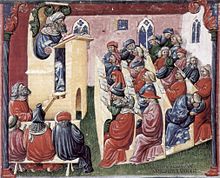
The rapid economic and socio-cultural development of late medieval society in Europe created favorable intellectual and technological conditions for Gutenberg's invention: the entrepreneurial spirit of emerging capitalism increasingly made its impact on medieval modes of production, fostering economic thinking and improving the efficiency of traditional work-processes. The sharp rise of medieval learning and literacy amongst the middle class led to an increased demand for books which the time-consuming hand-copying method fell far short of accommodating. In this situation, the decentralised state of the medieval landscape allowed a certain freedom to pursue individual solutions beyond the restrictions imposed by political and religious authorities.[12]
Technological factors
At the same time, a number of medieval products and technological processes had reached a level of maturity which allowed their potential use for printing purposes. Gutenberg took up these far-flung strands, combined them into one complete and functioning system, and perfected the printing process through all its stages by adding a number of inventions and innovations of his own:
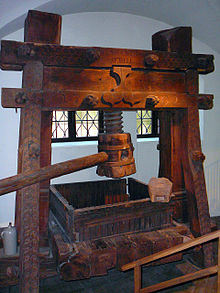
The screw press which allowed direct pressure to be applied on flat-plane was already of great antiquity in Gutenberg's time and was used for a wide range of tasks.[13] Introduced in the 1st century AD by the Romans, it was commonly employed in agricultural production for pressing wine grapes and (olive) oil seeds, both of which formed an integral part of the mediterranean and medieval diet.[14] The device was also used from very early on in urban contexts as a cloth press.[15] Gutenberg may have also been inspired by the paper presses which had spread through the German lands since the late 14th century and which worked on the same mechanical principles.[16]
Gutenberg adopted the basic design, thereby mechanizing the printing process.[17] Printing, however, put a demand on the machine quite different from pressing. Gutenberg adapted the construction so that the pressing power exerted by the platen on the paper was now applied both evenly and with the required sudden elasticity. To speed up the printing process, he introduced a movable undertable with a plane surface on which the sheets could be swiftly changed.[18]
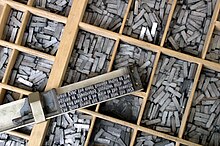
The concept of movable type was not entirely new in the 15th century; sporadic evidence that the typographical principle, the idea of creating a text by reusing individual characters, was well understood and employed in pre-Gutenberg Europe had been cropping up since the 12th century and possibly before (the ancient Phaistos disc aside). The known examples range from Germany (Prüfening inscription) to England (letter tiles) to Italy.[19] However, the various techniques employed (imprinting, punching and assembling individual letters) did not have the refinement and efficiency needed to become widely accepted.
Gutenberg greatly improved the process by treating typesetting and printing as two separate work steps. A goldsmith by profession, he created his type pieces from a lead-based alloy which suited printing purposes so well that it is still used today.[20] The mass production of metal letters was achieved by his key invention of a special hand mould, the matrix.[21] The Latin alphabet proved to be an enormous advantage in the process because, in contrast to logographic writing systems, it allowed the type-setter to represent any text with a theoretical minimum of only around two dozen different letters.[22]
Another factor conducive to printing arose from the book existing in the format of the codex, which had originated in the Roman period.[23] Considered the most important advance in the history of the book prior to printing itself, the codex had completely replaced the ancient scroll at the onset of the Middle Ages (500 AD).[24] The codex holds considerable practical advantages over the scroll format; it is more convenient to read (by turning pages), is more compact, less costly, and, in particular, unlike the scroll, both recto and verso could be used for writing − and printing.[25]

A fourth development was the early success of medieval papermakers at mechanizing paper manufacture. The introduction of water-powered paper mills, the first certain evidence of which dates to 1282,[26] allowed for a massive expansion of production and replaced the laborious handcraft characteristic of both Chinese[27] and Muslim papermaking.[28] Papermaking centres began to multiply in the late 13th century in Italy, reducing the price of paper to one sixth of parchment and then falling further; papermaking centers reached Germany a century later.[29]
Despite this it appears that the final breakthrough of paper depended just as much on the rapid spread of movable-type printing.[30] It is notable that codexes of parchment, which in terms of quality is superior to any other writing material,[31] still had a substantial share in Gutenberg's edition of the 42-line Bible.[32] After much experimentation, Gutenberg managed to overcome the difficulties which traditional water-based inks caused by soaking the paper, and found the formula for an oil-based ink suitable for high-quality printing with metal type.[33]
How a Printing Press Works
A printing press, in its classical form, is a standing mechanism, ranging from 5 to 7 feet long, 3 feet wide, and 7 feet tall. Type arranged into pages is placed in a frame to make a forme, which itself is placed onto a flat stone or 'bed'. The type is inked, and the paper is held between a frisket and tympan (two frames covered with paper or parchment). These are folded down, so that the paper lies on the surface of the inked type. The bed is rolled under the platen, using a windlass mechanism, and the impression is made with a screw that transmits pressure through the platen. Then the screw is reversed, the windlass turned again to move the bed back to its original position, the tympan and frisket raised and opened, and the printed sheet removed. Such presses were always worked by hand. After around 1800, iron presses were developed, some of which could be operated by steam power.
Gutenberg's press
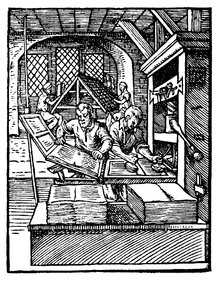
Johannes Gutenberg's work on the printing press began in approximately 1436 when he partnered with Andreas Dritzehn—a man he had previously instructed in gem-cutting—and Andreas Heilmann, owner of a paper mill.[34] However, it was not until a 1439 lawsuit against Gutenberg that an official record exists; witnesses' testimony discussed Gutenberg's types, an inventory of metals (including lead), and his type molds.[34]
Having previously worked as a professional goldsmith, Gutenberg made skillful use of the knowledge of metals he had learned as a craftsman. He was the first to make type from an alloy of lead, tin, and antimony, which was critical for producing durable type that produced high-quality printed books and proved to be much better suited for printing than all other known materials. To create these lead types, Gutenberg used what is considered one of his most ingenious inventions,[34] a special matrix enabling the quick and precise molding of new type blocks from a uniform template. His type case is estimated to have contained around 290 separate letter boxes, most of which were required for special characters, ligatures, punctuation marks, etc.[35]
Gutenberg is also credited with the introduction of an oil-based ink which was more durable than the previously used water-based inks. As printing material he used both paper and vellum (high-quality parchment).
In the Gutenberg Bible, Gutenberg made a trial of coloured printing for a few of the page headings, present only in some copies.[36] A later work, the Mainz Psalter of 1453, presumably designed by Gutenberg but published under the imprint of his successors Johann Fust and Peter Schöffer, had elaborate red and blue printed initials.[37]
The Printing Revolution
The phenomenon of the Printing Revolution can be approached from a quantitative perspective which has its focus on the printing output and the spread of the related technology. It can also be analysed in terms of how the wide circulation of information and ideas acted as an "agent of change" (Eisenstein) in Europe and global society in general.
Mass production and spread of printed books
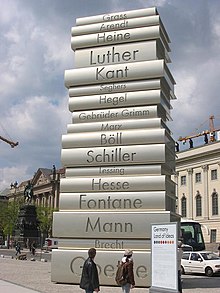
The invention of mechanical movable type printing led to an explosion of printing activities in Europe within only a few decades. From a single print shop in Mainz, Germany, printing had spread to no less than 236 cities in twelve European countries by the end of the 15th century.[7] As early as 1480, there were printers active in 110 different places in Germany, Italy, France, Spain, the Netherlands, Belgium, Switzerland, England, Bohemia and Poland.[7] From that time on, it is assumed that "the printed book was in universal use in Europe".[7]
In Italy, a center of early printing, print shops had been established in 77 cities and towns by 1500. At the end of the following century, 151 locations in Italy had seen at one time printing activities, with a total of nearly three thousand printers known to be active. Despite this proliferation, printing centres soon emerged; thus, one third of the Italian printers published in Venice.[38]
By 1500, the printing presses in operation throughout Western Europe had already produced more than twenty million volumes.[7] In the following century, their output rose tenfold to an estimated 150 to 200 million copies.[7]
European printing presses of around 1600 were capable of producing 3,600 impressions per workday.[4] By comparison, Far Eastern printing, which did not use presses and was solely done by manually rubbing the back of the paper to the page,[39] did not exceed an output of forty pages per day.[5]
The vast printing capacities meant that individual authors could now become true bestsellers: Of Erasmus's work, at least 750,000 copies were sold during his lifetime alone (1469−1536).[40] In the early days of the Reformation, the revolutionary potential of bulk printing took princes and papacy alike by surprise. In the period from 1518 to 1524, the publication of books in Germany alone skyrocketed sevenfold; between 1518 and 1520, Luther's tracts were distributed in 300,000 printed copies.[41]
The rapidity of typographical text production, as well as the sharp fall in unit costs, led to the issuing of the first newspapers (see Relation) which opened up an entirely new field for conveying up-to-date information to the public.[42]
A lasting legacy are the prized incunable, surviving pre-16th century print works which are collected by many of the most prestigious libraries in Europe and North America.[43]
Circulation of information and ideas

The printing press was also a factor in the establishment of a community of scientists who could easily communicate their discoveries through the establishment of widely disseminated scholarly journals, helping to bring on the scientific revolution.[citation needed] Because of the printing press, authorship became more meaningful and profitable. It was suddenly important who had said or written what, and what the precise formulation and time of composition was. This allowed the exact citing of references, producing the rule, "One Author, one work (title), one piece of information" (Giesecke, 1989; 325). Before, the author was less important, since a copy of Aristotle made in Paris would not be exactly identical to one made in Bologna. For many works prior to the printing press, the name of the author has been entirely lost.[citation needed]
Because the printing process ensured that the same information fell on the same pages, page numbering, tables of contents, and indices became common, though they previously had not been unknown.[citation needed] The process of reading also changed, gradually moving over several centuries from oral readings to silent, private reading.[citation needed] The wider availability of printed materials also led to a drastic rise in the adult literacy rate throughout Europe.[citation needed]
The printing press was an important step towards the democratization of knowledge.[44][45] Within fifty or sixty years of the invention of the printing press, the entire classical canon had been reprinted and widely promulgated throughout Europe (Eisenstein, 1969; 52). Now that more people had access to knowledge both new and old, more people could discuss these works. Furthermore, now that book production was a more commercial enterprise, the first copyright laws[citation needed] were passed to protect what we now would call intellectual property rights[citation needed]. A second outgrowth of this popularization of knowledge was the decline of Latin as the language of most published works, to be replaced by the vernacular language of each area, increasing the variety of published works. The printed word also helped to unify and standardize the spelling and syntax of these vernaculars, in effect 'decreasing' their variability. This rise in importance of national languages as opposed to pan-European Latin is cited as one of the causes of the rise of nationalism in Europe.
Book printing as art form
For years, book printing was considered a true art form. Typesetting, or the placement of the characters on the page, including the use of ligatures, was passed down from master to apprentice. In Germany, the art of typesetting was termed the "black art," in allusion to the ink-covered printers. It has largely been replaced by computer typesetting programs, which make it easy to get similar results more quickly and with less physical labor. Some practitioners continue to print books the way Gutenberg did. For example, there is a yearly convention of traditional book printers in Mainz, Germany.
Some theorists, such as McLuhan, Eisenstein, Kittler, and Giesecke, see an "alphabetic monopoly" as having developed from printing, removing the role of the image from society. Other authors stress that printed works themselves are a visual medium. Certainly, modern developments in printing have revitalized the role of illustrations.
Industrial printing presses
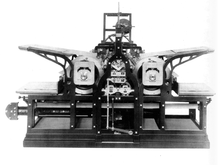
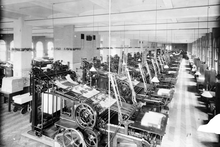

At the dawn of the Industrial Revolution, the mechanics of the hand-operated Gutenberg-style press were still essentially unchanged, although new materials in its construction, amongst other innovations, had gradually improved its printing efficiency. By 1800, Lord Stanhope had built a press completely from cast iron which reduced the force required by 90%, while doubling the size of the printed area.[46] With a capacity of 480 pages per hour, it doubled the output of the old style press.[47] Nonetheless, the limitations inherent to the traditional method of printing became obvious.
Two ideas altered the design of the printing press radically: First, the use of steam power for running the machinery, and second the replacement of the printing flatbed with the rotary motion of cylinders. Both elements were for the first time successfully implemented by the German printer Friedrich Koenig in a series of press designs devised between 1802 and 1818.[48] Having moved to London in 1804, Koenig soon met Thomas Bensley and secured financial support for his project in 1807.[46] Patented in 1810, Koenig had designed a steam press "much like a hand press connected to a steam engine."[46] The first production trial of this model occurred in April 1811. He produced his machine with assistance from German engineer Andreas Friedrich Bauer.
Koenig and Bauer sold two of their first models to The Times in London in 1814, capable of 1,100 impressions per hour. The first edition so printed was on November 28, 1814. They went on to perfect the early model so that it could print on both sides of a sheet at once. This began the long process of making newspapers available to a mass audience (which in turn helped spread literacy), and from the 1820s changed the nature of book production, forcing a greater standardization in titles and other metadata. Their company Koenig & Bauer AG is still one of the world's largest manufacturers of printing presses today.
The steam powered rotary printing press, invented in 1843 in the United States by Richard M. Hoe,[49] allowed millions of copies of a page in a single day. Mass production of printed works flourished after the transition to rolled paper, as continuous feed allowed the presses to run at a much faster pace.
Also, in the middle of the 19th century, there was a separate development of jobbing presses, small presses capable of printing small-format pieces such as billheads, letterheads, business cards, and envelopes. Jobbing presses were capable of quick set-up (average setup time for a small job was under 15 minutes) and quick production (even on treadle-powered jobbing presses it was considered normal to get 1,000 impressions per hour [iph] with one pressman, with speeds of 1,500 iph often attained on simple envelope work).[citation needed] Job printing emerged as a reasonably cost-effective duplicating solution for commerce at this time.
By the late 1930s or early 1940s, printing presses had increased substantially in efficiency: a model by Platen Printing Press was capable of performing 2,500 to 3,000 impressions per hour.[citation needed]
Other inventions in this field include the following:
- Color printing
- Lithography
- Offset printing
- Desktop publishing
- Electronic publishing
- Computer printer
- Composing stick
Printing capacity
The table lists the maximum number of pages which the various press designs could print per hour.
| Hand-operated presses | Steam-powered presses | |||||
|---|---|---|---|---|---|---|
| Gutenberg-style ca. 1600 |
Stanhope press ca. 1800 |
Koenig press 1812 |
Koenig press 1813 |
Koenig press 1814 |
Koenig press 1818 | |
| Impressions per hour | 240 [4] | 480 [47] | 800 [50] | 1,100 [51] | 2,000 [48] | 2,400 [48] |
See also
General
Printing presses
Notes
- ^ See People of the Millennium for an overview of the wide acclaim. In 1999, the A&E Network ranked Gutenberg no. 1 on their "People of the Millennium" countdown. In 1997, Time–Life magazine picked Gutenberg's invention as the most important of the second millennium; the same did four prominent US journalists in their 1998 resume 1,000 Years, 1,000 People: Ranking The Men and Women Who Shaped The Millennium. The Johann Gutenberg entry of the Catholic Encyclopedia describes his invention as having made a practically unparalleled cultural impact in the Christian era.
- ^ McLuhan 1962; Eisenstein 1980; Febvre & Martin 1997; Man 2002
- ^ McLuhan 1962, p. 124:
The invention of typography confirmed and extended the new visual stress of applied knowledge, providing the first uniformly repeatable commodity, the first assembly-line, and the first mass production.
- ^ a b c d Wolf 1974, pp. 67f.:
From old price tables it can be deduced that the capacity of a printing press around 1600, assuming a fifteen-hour workday, was between 3,200 and 3,600 impressions per day.
- ^ a b Ch'on Hye-bong 1993, p. 12:
This method almost doubled the printing speed and produced more than 40 copies a day. Printing technology reached its peak at this point.
- ^ Issawi 1980, pp. 492; Duchesne 2006, p. 83
- ^ a b c d e f g h Febvre, Lucien; Martin, Henri-Jean (1976): "The Coming of the Book: The Impact of Printing 1450-1800", London: New Left Books, quoted in: Anderson, Benedict: "Comunidades Imaginadas. Reflexiones sobre el origen y la difusión del nacionalismo", Fondo de cultura económica, Mexico 1993, ISBN 978-968-16-3867-2, pp. 58f.
- ^ Weber 2006, p. 387:
At the same time, then, as the printing press in the physical, technological sense was invented, 'the press' in the extended sense of the word also entered the historical stage. The phenomenon of publishing was born.
- ^ Francis Bacon: "Novum Organum, Liber I, CXXIX" − Adapted from the 1863 translation:
Printing, gunpowder and the compass: These three have changed the whole face and state of things throughout the world; the first in literature, the second in warfare, the third in navigation; whence have followed innumerable changes, in so much that no empire, no sect, no star seems to have exerted greater power and influence in human affairs than these mechanical discoveries.
- ^ Anderson, Benedict: "Comunidades Imaginadas. Reflexiones sobre el origen y la difusión del nacionalismo", Fondo de cultura económica, Mexico 1993, ISBN 978-968-16-3867-2, pp.63−76
- ^ Gerhardt 1978, p. 217
- ^ Eisenstein 1980; Febvre & Martin 1997; Man 2002
- ^ Wolf 1974, pp. 21−35
- ^ Onken 2009; White 1984, pp. 31f.; Schneider 2007, pp. 156−159
- ^ Schneider 2007, p. 158
- ^ Schulte 1939, p. 56
- ^ Wolf 1974, pp. 39f.
- ^ Wolf 1974, pp. 39−46
- ^ Germany: Brekle 1995, pp. 23–26; Brekle 1997, p. 62; Brekle 2005, p. 25; England: Lehmann-Haupt 1940, pp. 93–97; Brekle 1997, p. 62; Italy: Lipinsky 1986, pp. 75–80; Koch 1994, p. 213. Lipinsky surmises that this typographical technique was known in Constantinople from the 10th to 12th century and that the Venetians received it from there (p. 78).
- ^ Encyclopædia Britannica 2006: "Printing", retrieved November 27, 2006
- ^ Childress 2008, pp. 51–55
- ^ Childress 2008, pp. 51–55; Hellinga 2007, p. 208:
Gutenberg's invention took full advantage of the degree of abstraction in representing language forms that was offered by the alphabet and by the Western forms of script that were current in the fifteenth century.
- ^ Roberts & Skeat 1983, pp. 24−30
- ^ Roberts & Skeat 1983, pp. 1, 38−67, 75:
The most momentous development in the history of the book until the invention of printing was the replacement of the roll by the codex; this we may define as a collection of sheets of any material, folded double and fastened together at the back or spine, and usually protected by covers. (p. 1)
- ^ Roberts & Skeat 1983, pp. 45−53. Technically speaking, a scroll could be written on its back side, too, but the very few ancient specimen found indicate that this was never considered a viable option. (p. 46)
- ^ Burns 1996, p. 418
- ^ Thompson 1978, p. 169; Tsien, Tsuen-Hsuin 1985, pp. 68−73; Lucas 2005, p. 28, fn. 70
- ^ Thompson 1978, p. 169; Burns 1996, pp. 414−417
- ^ Burns 1996, p. 417
- ^ Febvre & Martin 1997, pp. 41−44; Burns 1996, p. 419:
In the West, the only inhibiting expense in the production of writings for an increasingly literate market was the manual labor of the scribe himself. With his mechanization by movable-type printing in the 1440's, the manufacture of paper, until then relatively confined, began to spread very widely. The Paper Revolution of the thirteenth century thus entered a new era.
- ^ Roberts & Skeat 1983, pp. 7f.:
Despite all that has been said above, even the strongest supporters of papyrus would not deny that parchment of good quality is the finest writing material ever devised by man. It is immensely strong, remains flexible indefinitely under normal conditions, does not deteriorate with age, and possesses a smooth, even surface which is both pleasant to the eye and provides unlimited scope for the finest writing and illumination.
- ^ The ratio between paper and parchment copies is estimated at around 150 to 30 (Hanebutt-Benz 2000, pp. 158−189).
- ^ Childress 2008, p. 60
- ^ a b c Meggs, Philip B. A History of Graphic Design. John Wiley & Sons, Inc. 1998. (pp 58–69) ISBN 0-471-291-98-6
- ^ Mahnke 2009, p. 290
- ^ Kapr 1996, p. 172
- ^ Kapr 1996, p. 203
- ^ Borsa 1976, p. 314; Borsa 1977, p. 166−169
- ^ Needham 1965, p. 211:
Widmann 1974, p. 34, fn. 14:The outstanding difference between the two ends of the Old World was the absence of screw-presses from China, but this is only another manifestation of the fact that this basic mechanism was foreign to that culture.
Duchesne 2006, p. 83; Man 2002, pp. 112−115:In East Asia, both woodblock and movable type printing were manual reproduction techniques, that is hand printing.
Encyclopædia Britannica 2006: "Printing":Chinese paper was suitable only for calligraphy or block-printing; there were no screw-based presses in the east, because they were not wine-drinkers, didn’t have olives, and used other means to dry their paper.
The second necessary element was the concept of the printing press itself, an idea that had never been conceived in the Far East.
- ^ Issawi 1980, pp. 492
- ^ Duchesne 2006, p. 83
- ^ Weber 2006, pp. 387f.
- ^ The British Library Incunabula Short Title Catalogue gives 29,777 separate editions (not copies) as of 8th January 2008, which however includes some print items from the 16th century (retrieved 11.03.2010). According to Bettina Wagner: "Das Second-Life der Wiegendrucke. Die Inkunabelsammlung der Bayerischen Staatsbibliothek", in: Griebel, Rolf; Ceynowa, Klaus (eds.): "Information, Innovation, Inspiration. 450 Jahre Bayerische Staatsbibliothek", K G Saur, München 2008, ISBN 978-3-598-11772-5, pp. 207–224 (207f.), the Incunabula Short Title Catalogue lists 28,107 editions published before 1501.
- ^ Malte Herwig, "Google's Total Library", Spiegel Online International, Mar. 28, 2007.
- ^ Howard Rheingold, "Moblogs Seen as a Crystal Ball for a New Era in Online Journalism", Online Journalism Review, Jul. 9, 2009.
- ^ a b c Meggs, Philip B. A History of Graphic Design. John Wiley & Sons, Inc. 1998. (pp 130–133) ISBN 0-471-291-98-6
- ^ a b Bolza 1967, p. 80
- ^ a b c Bolza 1967, p. 88
- ^ Meggs, Philip B. (1998). A History of Graphic Design (Third ed.). John Wiley & Sons, Inc. p. 147. ISBN 978-0471291985.
- ^ Bolza 1967, p. 83
- ^ Bolza 1967, p. 87
References
On the effects of the printing press
- Eisenstein, Elizabeth L. (1980), The Printing Press as an Agent of Change, Cambridge University Press, ISBN 0-521-29955-1
- Eisenstein, Elizabeth L. (2005), The Printing Revolution in Early Modern Europe (2nd, rev. ed.), Cambridge University Press, ISBN 0-521-60774-4 [More recent, abridged version]
- Febvre, Lucien; Martin, Henri-Jean (1997), The Coming of the Book: The Impact of Printing 1450-1800, London: Verso, ISBN 1-85984-108-2
- Man, John (2002), The Gutenberg Revolution: The Story of a Genius and an Invention that Changed the World, London: Headline Review, ISBN 978-0747245049
- McLuhan, Marshall (1962), The Gutenberg Galaxy: The Making of Typographic Man (1st ed.), University of Toronto Press, ISBN 978-0802060419
Technology of printing
- Bechtel, G. (1992), Gutenberg et l'invention de l'imprimerie, Paris: Fayard, ISBN 2-213-02865-6
- Bolza, Hans (1967), "Friedrich Koenig und die Erfindung der Druckmaschine", Technikgeschichte, 34 (1): 79–89
- Borsa, Gedeon (1976), "Druckorte in Italien vor 1601", Gutenberg-Jahrbuch: 311–314
- Borsa, Gedeon (1977), "Drucker in Italien vor 1601", Gutenberg-Jahrbuch: 166–169
- Brekle, Herbert E. (1995), "Eine weitere Spur einer typographischen Werkstatt beim Kloster Prüfening im 12. Jahrhundert", Gutenberg-Jahrbuch, 70: 23–26
- Brekle, Herbert E. (1997), "Das typographische Prinzip. Versuch einer Begriffsklärung", Gutenberg-Jahrbuch, 72: 58–63
- Brekle, Herbert E. (2005), Die Prüfeninger Weihinschrift von 1119. Eine paläographisch-typographische Untersuchung (brief summary), Regensburg: Scriptorium Verlag für Kultur und Wissenschaft, ISBN 3-937527-06-0
- Burns, Robert I. (1996), "Paper comes to the West, 800−1400", in Lindgren, Uta (ed.), Europäische Technik im Mittelalter. 800 bis 1400. Tradition und Innovation (4th ed.), Berlin: Gebr. Mann Verlag, pp. 413–422, ISBN 3-7861-1748-9
- Childress, Diana (2008), Johannes Gutenberg and the Printing Press, Minneapolis: Twenty-First Century Books, ISBN 978-0-7613-4024-9
- Ch'on Hye-bong: "Typography in Korea", Koreana, Vol. 7, No. 2 (1993), pp. 10−19
- Stearns, Peter N. (ed.). Encyclopedia of World History (6th ed.). The Houghton Mifflin Company/Bartleby.com.
Citation
- Crompton, Samuel Willard (2004), The Printing Press. Transforming Power of Technology, Philadelphia: Chelsea House Publishers, ISBN 0-7910-7451-X
- Duchesne, Ricardo (2006), "Asia First?", The Journal of the Historical Society, 6 (1): 69–91
- Fontaine, Jean-Paul (1999), L'aventure du livre: Du manuscrit medieval a nos jours, Paris: Bibliothèque de l'image
- Gerhardt, Claus W. (1971), "Warum wurde die Gutenberg-Presse erst nach über 350 Jahren durch ein besseres System abgelöst?", Gutenberg-Jahrbuch: 43–57
- Gerhardt, Claus W. (1978), "Besitzt Gutenbergs Erfindung heute noch einen Wert?", Gutenberg-Jahrbuch: 212–217
- Hanebutt-Benz, Eva-Maria (2000), "Gutenbergs Erfindungen", Gutenberg. Aventur und Kunst: Vom Geheimunternehmen zur ersten Medienrevolution, Mainz: Stadt Mainz, pp. 158−189
- Hellinga, Lotte (2007), "The Gutenberg Revolutions", in Eliot, Simon; Rose, Jonathan (eds.), A Companion to the History of the Book, Blackwell Publishing, pp. 207−220, ISBN 978-1-4051-2765-3
- Hind, Arthur M., An Introduction to a History of Woodcut, Houghton Mifflin Co. 1935 (in USA), reprinted Dover Publications, 1963 ISBN 0-486-20952-0
- Issawi, Charles (1980), "Europe, the Middle East and the Shift in Power: Reflections on a Theme by Marshall Hodgson", Comparative Studies in Society and History, 22 (4): 487–504
- Kapr, Albert (1996), Johannes Gutenberg. The Man and his Invention, Aldershot: Scolar, ISBN 1-85928-114-1
- Koch, Walter (1994), Literaturbericht zur mittelalterlichen und neuzeitlichen Epigraphik (1985−1991), Monumenta Germaniae Historica: Hilfsmittel, vol. 14, München, p. 213, ISBN 978-3886121144
{{citation}}: CS1 maint: location missing publisher (link) - Lehmann-Haupt, Hellmut (1940), "Englische Holzstempelalphabete des XIII. Jahrhunderts", Gutenberg-Jahrbuch: 93–97
- Lipinsky, Angelo (1986), "La pala argentea del Patriarca Pellegrino nella Collegiata di Cividale e le sue iscrizioni con caratteri mobili", Ateneo Veneto, 24: 75–80
- Lucas, Adam Robert (2005), "Industrial Milling in the Ancient and Medieval Worlds. A Survey of the Evidence for an Industrial Revolution in Medieval Europe", Technology and Culture, 46 (1): 1–30
- Mahnke, Helmut (2009), Der kunstreiche Johannes Gutenberg und die Frühzeit der Druckkunst, Norderstedt: Books on Demand, ISBN 9-783837-050417
- Needham, Joseph: "Science and Civilisation in China", Physics and Physical Technology (Vol. 4), Mechanical Engineering (Part 2), Cambridge University Press, 1965
- Onken, Björn (2009), "Presses", in Cancik, Hubert; Schneider, Helmuth (eds.), Brill's New Pauly
- Encyclopædia Britannica 2006: "Printing", retrieved November 27, 2006
- Roberts, Colin H.; Skeat, T. C. (1983), The Birth of the Codex, London: Oxford University Press, ISBN 0-19-726024-1
- Schneider, Helmuth (2007), "Technology", in Scheidel, Walter; Morris, Ian; Saller, Richard (eds.), The Cambridge Economic History of the Greco-Roman World, Cambridge University Press, pp. 144–171, ISBN 978-0-521-78053-7
- Schulte, Alfred (1939), "Papierpresse, Druckerpresse und Kelter", Gutenberg-Jahrbuch: 52–56
- Thompson, Susan (1978), "Paper Manufacturing and Early Books", Annals of the New York Academy of Sciences, 314: 167–176
- Tsien, Tsuen-Hsuin: "Science and Civilisation in China", Chemistry and Chemical Technology (Vol. 5), Paper and Printing (Part 1), Cambridge University Press, 1985
- Weber, Johannes (2006), "Strassburg, 1605: The Origins of the Newspaper in Europe", German History, 24 (3): 387–412
- White, K. D. (1984), Greek and Roman Technology, London: Thames and Hudson
- Widmann, Hans (1974), "Der koreanische Buchdruck und Gutenbergs Erfindung", Gutenberg-Jahrbuch: 32–34
- Wolf, Hans-Jürgen (1974), Geschichte der Druckpressen (1st ed.), Frankfurt/Main: Interprint
External links
- Centre for the History of the Book
- Gutenberg printing − Photos of Incunabula and the Gutenberg Bible (1455)
- BGDP − Safety on printing presses
- Internet Archive: Printing (1947) − a film from the Prelinger Archives explaining the printing industry
- Careers for the 21st Century: Printing Press Operators
- Qualifications For A Press Operator
